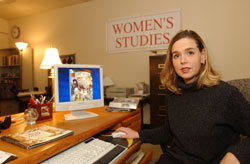WIU Professor Tackles Issues With Fairy Tales
December 10, 2003

Lori Baker-Sperry
[Download Print-Quality Image]
MACOMB, IL - - Generations of children have been brought up loving fairy tales such as Cinderella and Snow White, but a recent study revealing the prevalence of the feminine beauty ideal and how it perpetuates traditional gender roles has struck a nerve that wraps around the globe.
News wires, major newspapers and internet news sites have run information deduced from a sociological study by Western Illinois University Assistant Professor Lori Baker-Sperry and Purdue University Associate Professor Liz Grauerholz on The Pervasiveness and Persistence of the Feminine Beauty Ideal in Childrens Fairy Tales. The research study appears in Octobers Gender and Society professional journal.
Since publication, there has been a strong media response, both positive and negative. I believe this attests to the importance and impact of the fairy tale still today. Childrens media can be a powerful mechanism by which children learn cultural values. In fact, this was the original impetus of the study. Baker-Sperry said.
Through the proliferation of fairy tales in the media, girls (and boys) are taught specific messages concerning the importance of womens bodies and womens attractiveness. We are concerned that messages of how looks can label a person as good or bad is harmful to children, she added. The recommendation we make is to have parent or adult interaction while children read or view fairy tales.
Baker-Sperry said that the feminine beauty ideal in childrens fairy tales can provide insight into the dynamic relationship between gender, power, and culture as well as the cultural and social significance of beauty to womens lives.
Several patterns emerged from the study, including the associations between beauty and economic privilege, beauty and race, beauty and goodness, and beauty and danger.
Often there is a clear link between beauty and goodness, most often in reference to younger women, and between ugliness and evil, Baker-Sperry said.
The study, an outgrowth of Baker-Sperrys masters thesis at Purdue University, included 168 Brothers Grimm fairy tales with human characters, written in the 1800s, which had been translated to English and brought to America. One-fourth (43) of the tales analyzed have been reproduced in childrens books or movies, with five fairy tales - - Cinderella, Snow White, Sleeping Beauty, Little Red Riding Hood and Hansel and Gretel - - making up more than two-thirds (72.7 percent) of all reproductions.
As the only study to offer a historical analysis of the reproduction of a beauty ideal in fairy tales, this research provides critical insight into ways in which childrens literature has been shaped by political and social forces over time and yet continues to provide traditional gendered prescriptions for women, Baker-Sperry said.
The messages presented in the Grimms tales portray differing means of status attainment for women and for men, especially white, heterosexual women, she added. The pervasiveness of fairy tales in our society, through books and movies, suggest that there are many opportunities for these messages to become internalized.
Baker-Sperry said she does not discourage sharing fairy tales with children.
I intentionally read fairy tales to my 4-year-old daughter to expose her to these issues, she said. And we talk about whats real and whats just a story. Even at four shes able to separate what real women can do and become from those portrayed in fairy tales.
Baker-Sperry, in her fifth year of teaching at her alma mater, has two other professional publications: Passing on the Faith: The Role of the Father in Religious Development in Sociological Focus (2001) and Bringing Gender to Life in the Classroom: Recommended Videos That Teach About Gender in Teaching Sociology (1999).
Baker-Sperry earned her bachelors degree (1996) at Western Illinois. Her masters degree (1998) and doctorate (2001) are from Purdue.
Link to Purdue News
Posted By: University Communications (U-Communications@wiu.edu)
Office of University Communications & Marketing

Connect with us: